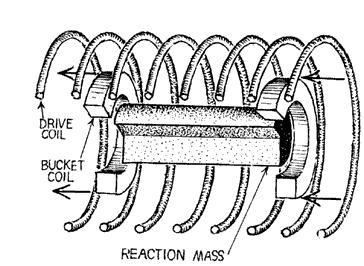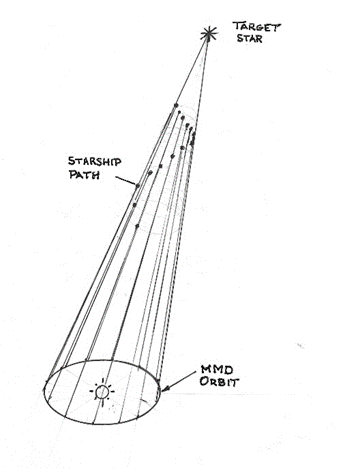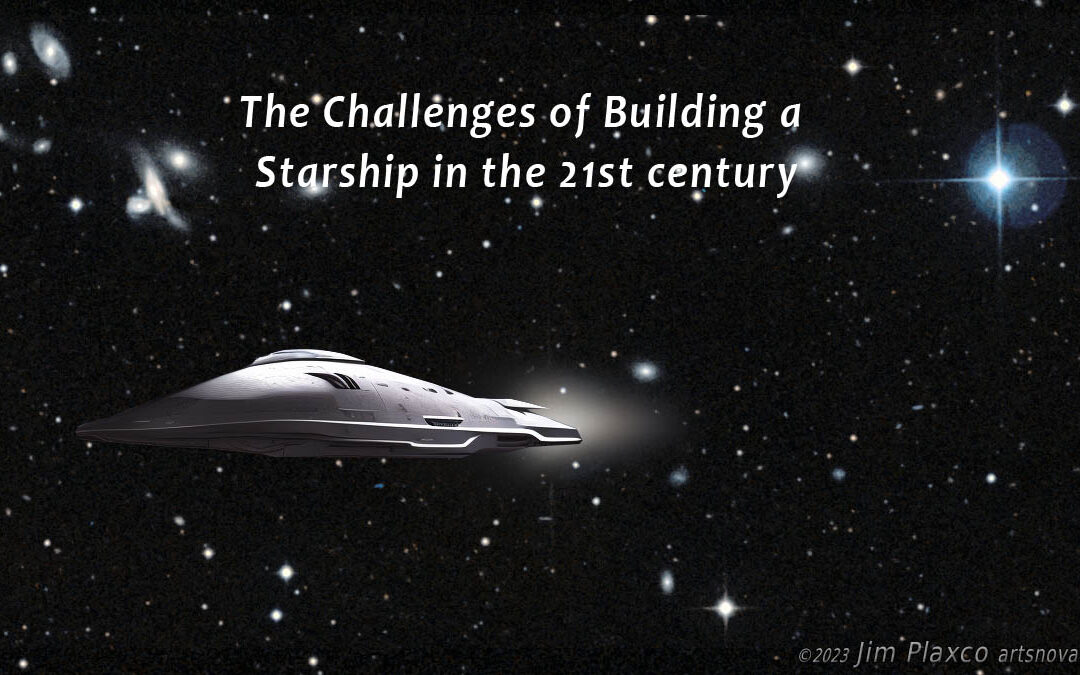Introduction
My goal in my online book at https://www.allthingsspace.info and this series of articles was to see what a starship would look like if designed and built this century. This meant I would only use current or those technologies that with a decade or two of reasonable extrapolation, would be available. In the first article I laid out the challenges and some of the physical limitations that constrain our design by reviewing the rocket equation and the concept of gravitational slingshots. In the second article I came up with some engineering and technical requirements in order to escape the sun’s gravity and achieve a velocity of 300kps.A two-stage configuration was needed, the first to conduct a 10kps powered maneuver past the sun. From a mass perspective a powered maneuver would limit the m1 size to only about 200,000mt. Furthermore, the need for a 4300-year mission meant the need for a large, crewed vessel. This drives the need for a large toroidal crew habitat and a second torus for supplies and power, together massing 38,000 mt. Furthermore, a crewed mission requires extensive cosmic ray protection of 550,000 mt. To this mass we would need to add the mass of our power supply, engines, consumables, and reaction mass to slow down which is more than our 200,000mt available and would seem to make a starship impossible.
This article will address a way around this issue so that we can send out a starship this century.
Problem Scope
Requirement- Slowing Down at the Target Star
The need to decelerate is problematic.If we want to have a starship that arrives at the target star with a m1 mass of 200,000mt, travels at 300kps, and has an engine specific impulse of 10,000, using the rocket equation our m0 will need to be 4million mt when we begin decelerating.This is too large for us to perform a powered maneuver at the beginning of the voyage and our second stage mass will be so large that our electric propulsion will take thousands of years to accelerate to 300kps. In addition, this amount of mass for the electric propulsion typically would be a noble gas and be sourced from earth.Isolating and launching 3.8 million mt of noble gas would require tens of thousands of rocket launches. Electric propulsion can provide more substantial thrust but only if the power supply is dramatically increased.Unfortunately, the mass of the power supply will increase linearly with thrust and will quickly consume all of our available m1 mass.
Solution – Changing the Mission Profile- Enroute Mass Supply
Even with a relatively lightweight but high-power reactor there is no way of developing a reasonably starship with current technology unless we fundamentally rethink our mission profile.
In 1979 Clifford E Singer made a speculative proposal to launch millions of pellets with a large mass driver (Singer, 1979). A mass driver is similar to an electric propulsion thruster except it accelerates buckets filled with a mass/payload instead of individual ions. The pellets would impact the starship’s absorption plate and would impart their momentum to our rocket.
In Singers design the following was proposed:
- A mission to Barnards Star traveling at .12c (36,000kps)
- Pellets would be from 3-100 grams. For this scenario he picked a pellet 2.8grams
- The accelerator would be 105 km long.
- Acceleration of pellets would be on the order of .3 to 4 mega gravities (300,000 to 4 million g)
- For a 2.8 gram pellet, a 15 GW Power source was required over 3 years
- Two pellets would be launched each second at .25c (75,000 kps)
The challenges of building this sort of propulsion device are substantial. In short:
- Accuracy of the pellet and vehicle trajectory. Singer proposed that a dozen correcting stations be positioned 340 AU apart to ensure the pellets were accurately targeted.
- The tremendous speed of pellets leads to the requirements for a massive pellet launcher.
- The tremendous speed of the pellets requires a tremendous power supply.
- The tremendous speed of the pellets requires huge acceleration. Would we even be able to accelerate a pellet this quickly with electromagnetic means? Particle accelerators can but they are dealing with individual atoms.

Figure 1 – Simplified Mass Driver Operation (Kolm, 1980)
Despite these challenges, the pellet proposal has considerable merit.
- It transfers all the reaction mass to the pellets being launched from the solar system. His starship would carry no fuel/reaction mass (unless it needs to slow down at the target star). This means that Singer’s starship consists essentially of structure and payload only. Not having to waste most of your mass and therefore energy accelerating your dead fuel mass reduces the amount of mass needed substantially.
- Even though the amount of power needed to launch your pellets is substantial, it transfers most of the power needed to the Solar System where it can be generated far easier via Nuclear or Solar power. The ship does not need any power for propulsion.
- It is more efficient than a large laser accelerating a solar sail. Between laser efficiency issues and the dispersion of laser light over large distances, typically less than 5% of the power generated would go to propelling a solar sail spaceship.
By developing a far less ambitious version of this can we adapt this approach to our needs?
Packet resupply
How would such a mission work? As before we build a two stage ship whose first stage does a solar powered maneuver.This would put the starship on a hyperbolic escape trajectory toward our star.In the case of a dV of 10kps and with a 10 radii solar approach we would achieve a velocity of just over 60kps(note if we performed the same maneuver at 3 solar radii our speed would be an impressive 85kps).
At this stage, instead of using stored mass on our starship to continue our acceleration, we instead start picking up mass via “packets” that are lying in our starship path (or conversely, these mass packets catch up and are picked up from behind the starship).These packets would be then used as the reaction mass for our rocket.As with a jet engine, effectively NO reaction mass would be carried as the ship accelerates to 300kps.After this stage the starship would continue to pick up these packets but instead of using them to accelerate, we would use this mass to build up our cosmic ray protection, refuel our reactors, replace any consumables, and start accumulating reaction mass for our deceleration.
These packets would have been launched from a large asteroid based mass driver (henceforth called the Mega Mass Driver or MMD).The specifications for this mass driver will be impressive but much less challenging than that which was proposed by Singer. Our MMD would have the following specifications:
- Launch 20kg packets- half of this mass will consist of the accelerating bucket, electronics, solar panels and small ion engines, and the other half would be payload.
- Launch at speeds up to 300kps.
- Accelerate packets at 10,000g.
- MMD will be approximately 440km long.
- Launch at rapid fire rate-depending on the design and starship velocity up to 95 packets per second.

Figure 2 – Notional Starship Flight Profile and MMD Packet Trajectory
As conceived, each packet will be 50% payload, and 50% bucket/spacecraft.The bucket/spacecraft will generate the magnetic field necessary to allow the packet to be accelerated at 10,000g and after launch, receive power from solar panels illuminated by a laser beam.The purpose of these solar panels is receiving laser light to power electronics and sensors that would accurately track the packet and its relation to the packet in front of it.Over the first day or two of its journey, very small electric propulsion thruster will be used to fine tune its position so that the two packets will drift very little in relation to each other over the course of many years – with a target of no more than a meter or two drift per year. All this adjustment would be done when the packet is still relatively close to the MMD and being illuminated by a laser beam. Whether this level of trajectory accuracy is possible is highly speculative and considerable engineering and analysis would need to be performed.The method by which the packets would be captured by our starship would strongly constrain the acceptable rate of drift between packets. I would conceive of our starship having multiple capture nets by which a recovery net attached by a long cable to the ship would be fired at the approaching packet. The nets would capture the payload and then be reeled in to be processed for either propulsion or to build out our starship.
With this scheme the packet consists of both the bucket and spacecraft. Mass drivers have been considered before (primarily as a means to launch raw materials from a moon or asteroid without the need for a rocket) but in these scenarios, the bucket was kept and reused – it was decelerated after it had accelerated and released its payload.This may turn out to be necessary, but this will add considerable length and mass to our MMD since the buckets will now have to be decelerated and cycled back down to their starting point. However, an advantage to this scheme is that decelerating the buckets can recover a sizeable portion of our power and may be worth the effort.
Finally, whether the starship runs into the packets as it cruises along, or the packets catch up with the starship and are picked up, would have to be decided based on an analysis that weighs the positive and negatives of each method.
Selecting the Propulsion- Electric Propulsion or Mass Driver for our Starship?
We need a specific impulse for our starship of around 10,000 seconds if we are to get close to 300kps. The packets will provide the reaction mass to complete our acceleration and enable our deceleration.As such, if a form of electric propulsion is used, the packet “payload” will likely be one of the typical reaction masses used by ion or plasma propulsion- a noble gas. This means that likely less than half the 20kg packet mass is used – or 10kg, assuming the other 10kg is for our bucket, electronics, solar panels and ion engines and our noble gas (likely chilled to a liquid) container.
An alternative to using electric propulsion is the same technology used for our MMD- a smaller mass driver to propel our starship.The performance of this starship mass driver (we will call this one the MD) will be much less than what was required for the MMD- the exhaust velocity for a specific impulse of 10,000 combined with a 10,000 g acceleration would require a driver length of “only” 49km.How much would an MD of this size mass?Since a large mass driver has never been built, it is difficult to determine.Depending on the size the starship mass packets are (I decided we would use a smaller mass of 1kg per launch) the buckets will be quite small- likely only a few cm in diameter.If the MD support structure is aluminum the mass could be quite low- I estimate about 500kg per meter.For reference, I found an article that stated that a large radio tower in North Dakota made of steel masses 392,131kg which converts to about 660kg per meter.The base of this tower has to support 392mt which equates to 3.9 million nt which does not even include the forces caused by wind loads. Our MD should have force only a fraction of this- if we accelerate a 1kg payload at 10000 g the force would be about 100,000nt. For a first estimate, I think 500kg per meter may not be unreasonable. Using this mass our MD will mass about 25,000mt.
We need to determine which will be a better source of thrust- electric propulsion or MD? I ran several scenarios, and it turns out that unless our starship is very small, it is more effective to go with a mass driver. With electric propulsion doubling your thrust will double your propulsion mass.With an MD, the thrust is periodic… for argument’s sake let’s say every ten seconds.You can double your thrust by firing every five seconds and the mass of your MD will not increase.
However, the biggest advantage of using a MD is that I assumed that we can use all the supplied packet mass for reaction mass, reducing the number of packets by 50% over using an electric propulsion. This also applies to the mass collected for deceleration.For each packet delivered if using an electric propulsion, at best only about 50% would be useable for reaction mass.
The third minor advantage to using an MD is likely to be the electric conversion efficiency- electric propulsion typically achieves a conversion efficiency of electric power to thrust of 50%.The mass driver estimates may approach 80% (Kolm, 1980).
Areas for Engineering Improvements
There would need to be considerable engineering work to verify this mission profile is possible. Some of the key technologies required:
- Develop the technology to accelerate buckets and payload at 10,000g with a large MMD
- Develop the MMD packet spacecraft, propulsion and guidance system to ensure accurate target positioning.
- Develop a lightweight MD for our starship that can accelerate a 1kg packet at 10,000g. Target mass goal for the MD would be 500kg per meter of length.
The industrial requirements are even more substantial. The largest are:
- Design and build a very large 440km MMD
- Develop space-based manufacturing capabilities to build our starship and the MMD
- Develop vary large power storage system to power the MMD. Depending on the final design (mass of packets, mass of ship, speed of approach to the ship. We will look at the MMD further in the next article)
- Develop manufacturing capabilities for mass production of our buckets.An analysis of the need to accelerate up to 300kps and then to build out our starship to a final m0 mass of 4 million mt indicates we will require a total of about 215 million packets of 20kg each. If our starship does not use an MMD and instead uses an electric propulsion with a payload of a noble gas, then the number of packets will approximately double.
The two technologies that could dramatically change our mission profile and simplify any starship design are Solar Sails and an advanced Nuclear Engine- either an advanced fission rocket or a fusion powered one. Because of the unknowns associated with their feasibility, I did not include these in my starship design. If extremely lightweight but strong materials could be made, then Solar Sails would drastically modify our mission.Launching millions of small solar sails that carry a small payload could eliminate the need for a large MMD and its associated power supply.Similarly, powerful, relatively lightweight fusion power could eliminate the need for our Starship MD.The fusion reactions could be used to generate both power and thrust and would likely be able to generate a specific impulse of 10,000 or more.Hopefully over the next few decades both technologies will advance enough that a revised starship design can be considered.
Conclusion
It appears technically feasible to build a starship without any fundamental new technologies though it would be extremely difficult.If designed now, the starship would have the following characteristics:
- A two-stage configuration, the first a high thrust engine to perform a powered maneuver to reach a solar system escape velocity, and the second a lower thrust mass driver.
- A 300kps top speed
- Enroute packet resupply will be needed both to provide reaction mass for our outbound stage 2 acceleration, as well as material to build out our cosmic ray protection, providing some resupply including fuel for our nuclear reactors) and build up the mass for our eventual deceleration.
- An m1 mass of about 200,000 mt for a crew of 1000 and an m0 mass of about 4million mt.
With all these characteristics, our starship would still require a voyage time of over 4300 years.
In the next article we will address some additional details and as well as lay out what our starship will look like.
A more complete assessment of the challenges of building a starship not addressed in this series of articles are discussed in my draft book published on my website https://www.allthingsspace.info.
References
- Kolm, Henry (1980), Mass Driver Update, September 1980, L5 News
- Singer, C. E. (1979). Interstellar Propulsion Using a Pellet Stream for Momentum Transfer. Princeton: Princeton University.
About the Author: David W McGuire is a retired veteran from the USAF and AF Reserve where he held various jobs as an Acquisition and Procurement Officer, C-5 Maintenance Officer, Maintenance Squadron Commander and Deputy Group Commander. He retired as a Colonel. He also has worked in the chemical, pipeline and petroleum industries where he held varied positions including Terminal Manager, Regional Accountant Manager, Regional Engineering Manager, and Regional Operations Director. He has a degree in Aerospace Engineering and an MBA.

